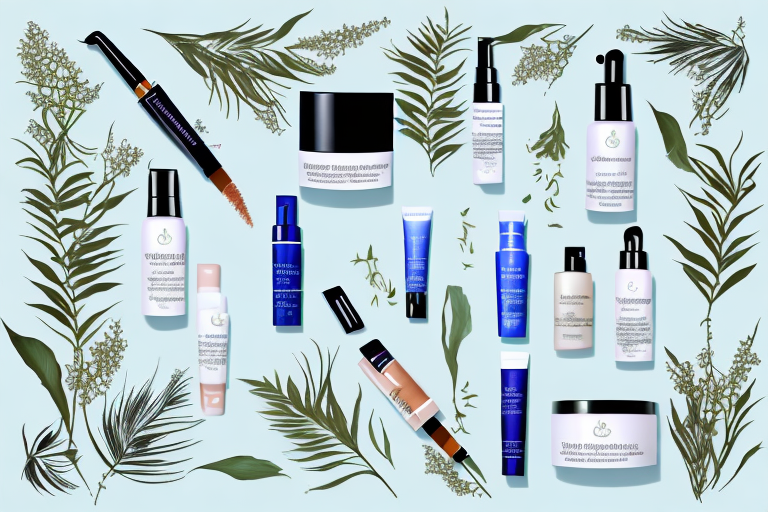Collaborative marketing has become increasingly popular in the skincare industry, with brands joining forces to promote their products and reach a wider audience. This article will explore the importance of collaboration in marketing and outline key principles for successful collaboration. It will also discuss how to identify potential partners, implement collaborative marketing strategies, measure their success, and overcome challenges along the way.
Understanding Collaborative Marketing in the Skincare Industry
In the competitive world of skincare, collaborative marketing has emerged as an effective strategy to gain a competitive edge. By partnering with other brands, skincare companies can pool their resources, share expertise, and amplify their marketing efforts. This approach not only helps brands expand their reach but also allows them to tap into new customer segments.
Collaborative marketing in the skincare industry is a dynamic and ever-evolving practice that requires a deep understanding of the market landscape and consumer preferences. It involves forging strategic alliances between skincare brands that have complementary products or target similar customer demographics. These partnerships can take various forms, such as co-branded campaigns, joint product launches, or even cross-promotions.
The Importance of Collaboration in Marketing
Collaboration plays a crucial role in marketing for several reasons. Firstly, it allows brands to leverage each other's strengths and assets, leading to more impactful campaigns. For example, a skincare brand known for its expertise in natural ingredients can collaborate with a brand that specializes in innovative packaging design, creating a powerful combination of product quality and visual appeal.
Secondly, collaboration fosters creativity and innovation, as different perspectives and ideas are brought together. When skincare brands join forces, they can tap into a diverse pool of talent and knowledge, resulting in fresh and exciting marketing initiatives. This collaborative approach encourages out-of-the-box thinking and pushes boundaries, ultimately benefiting both the brands involved and the consumers.
Lastly, by sharing costs and resources, brands can achieve greater efficiency and effectiveness in their marketing initiatives. Marketing campaigns can be costly, especially for smaller skincare companies with limited budgets. Collaborative marketing allows these brands to pool their resources, reducing individual financial burdens and maximizing the impact of their joint efforts. This cost-sharing aspect also opens up opportunities for brands to explore new marketing channels and reach a wider audience.
Key Principles of Collaborative Marketing
Successful collaborative marketing requires a strong foundation built on several key principles. Trust and transparency are paramount, as partners must be willing to share sensitive information and be open to feedback. Establishing clear communication channels and maintaining open lines of dialogue is essential to ensure that all parties are aligned and working towards the same goals.
Furthermore, clear and consistent messaging is crucial to maintaining brand integrity throughout joint campaigns. Skincare brands must ensure that their collaborative marketing efforts align with their core values and resonate with their target audience. By developing a unified brand voice and cohesive messaging, partners can create a seamless experience for consumers and enhance brand recognition.
It is equally important for partners to establish clear goals and define their roles and responsibilities from the outset. Collaborative marketing requires a shared vision and a mutual understanding of each brand's objectives. By setting specific goals and delineating responsibilities, brands can streamline their efforts and ensure that each partner contributes effectively to the overall success of the campaign.
In conclusion, collaborative marketing has become an integral part of the skincare industry, enabling brands to leverage each other's strengths, foster innovation, and achieve greater marketing efficiency. By embracing collaboration and adhering to key principles, skincare companies can unlock new opportunities for growth and establish themselves as industry leaders.
Identifying Potential Partners for Collaborative Marketing
To find the right partners for collaborative marketing, skincare brands must consider various factors. One important criterion is compatibility, both in terms of brand values and target audience. Collaborating with brands that share similar values ensures that the partnership remains authentic and resonates with the desired consumer base. This can include a shared commitment to sustainability, cruelty-free practices, or using natural ingredients. By partnering with like-minded brands, skincare companies can strengthen their message and appeal to a wider range of consumers.
Additionally, brands should look for partners with complementary products or expertise to create a mutually beneficial alliance. For example, a skincare brand specializing in anti-aging products may collaborate with a cosmetics brand known for its high-quality foundations and concealers. This partnership allows both brands to tap into each other's customer base and offer a more comprehensive solution to their consumers.
Criteria for Choosing the Right Partner
In selecting a suitable partner, skincare brands should evaluate the partner's reputation, credibility, and market presence. It is essential to ensure that the potential partner has a strong track record and is well-regarded within the industry. This can be determined by conducting thorough research, analyzing customer reviews, and assessing their overall brand image.
Furthermore, it is important to assess their marketing capabilities and resources to ensure they are aligned with the goals of the collaboration. This can include evaluating their social media presence, advertising campaigns, and previous collaborations. A partner with a robust marketing strategy and a sizable audience can significantly amplify the reach and impact of the collaborative marketing efforts.
Strong synergy between the brands is crucial for a successful partnership. This means that the brands should have a shared vision and complementary strengths. For instance, if one brand excels in product development and innovation, while the other has a strong distribution network, their collaboration can result in the creation of innovative products that reach a wider audience.
Building Mutually Beneficial Partnerships
Successful collaborative marketing relies on mutually beneficial partnerships. Skincare brands should seek to create win-win scenarios, where each partner gains value from the collaboration. This can involve sharing resources, cross-promoting products, or even co-developing new offerings.
Sharing resources can include joint marketing campaigns, where both brands contribute to the creation and funding of advertisements and promotions. This not only reduces the financial burden but also allows for the pooling of creative ideas and expertise. By leveraging each other's strengths, the brands can create impactful marketing materials that resonate with their target audience.
Cross-promoting products is another effective strategy for building mutually beneficial partnerships. This can involve featuring each other's products in marketing materials, offering special discounts or bundles when purchasing products from both brands, or even creating limited-edition collaborations. By introducing their customers to complementary products, the brands can increase their sales and enhance the overall customer experience.
In some cases, skincare brands may choose to co-develop new offerings with their partners. This can involve combining their expertise and resources to create innovative products that cater to a specific need or address a common concern. By collaborating on product development, the brands can leverage their shared knowledge and create unique offerings that stand out in the market.
By aligning their interests and goals, skincare brands can maximize the benefits of their collaboration. Through compatibility, careful evaluation, and a focus on creating mutually beneficial partnerships, skincare brands can effectively identify and engage with the right partners for collaborative marketing.
Implementing Collaborative Marketing Strategies
Once skincare brands have identified their partners, it is time to implement collaborative marketing strategies. This can take various forms, including co-branding and co-marketing initiatives, affiliate marketing programs, and influencer partnerships.
Co-Branding and Co-Marketing Strategies
Co-branding and co-marketing strategies involve two or more brands coming together to create a joint marketing campaign. This can include joint product launches, limited-edition collaborations, or co-hosted events. These strategies not only expose each brand's audience to the other but also create a sense of exclusivity and excitement among consumers.
Affiliate Marketing and Influencer Partnerships
Affiliate marketing programs and influencer partnerships have also proven to be effective collaborative marketing strategies in the skincare industry. By working with influencers and affiliates, brands can leverage their reach and credibility to promote their products. This approach allows for targeted marketing and increased consumer trust, leading to higher conversion rates.
Measuring the Success of Your Collaborative Marketing Efforts
As with any marketing strategy, measuring the success of collaborative marketing efforts is crucial to ensure its effectiveness and identify areas for improvement. Skincare brands should establish key performance indicators (KPIs) to track the impact of their collaborative campaigns. KPIs can include metrics such as sales revenue, website traffic, social media engagement, or customer acquisition. Regular monitoring and analysis of these metrics will provide valuable insights to optimize future collaborative marketing initiatives.
Key Performance Indicators for Collaborative Marketing
When evaluating the success of collaborative marketing efforts, skincare brands should consider both quantitative and qualitative metrics. Quantitative metrics provide numerical data, such as sales figures or website metrics, to assess the campaign's impact. Qualitative metrics, on the other hand, involve gathering feedback from customers and partners to gauge the overall perception of the collaboration and its effectiveness in achieving the desired objectives.
Adjusting Your Strategy Based on Performance Feedback
Performance feedback is essential for continuous improvement in collaborative marketing. Skincare brands should actively seek feedback from partners, customers, and other stakeholders involved in the collaboration. This feedback can help identify areas where the strategy can be adjusted or refined to maximize its impact and ensure long-term success.
Overcoming Challenges in Collaborative Marketing
Collaborative marketing, like any collaborative endeavor, can present challenges. Skincare brands must be aware of these challenges and develop strategies to overcome them for a smooth and effective partnership.
Navigating Differences in Brand Identity
When partnering with other brands, skincare companies must navigate potential differences in brand identity. It is essential to find a balance that respects both brands' uniqueness while maintaining a coherent and consistent message. Clear communication and mutual understanding are crucial to aligning brand values and presenting a cohesive image to consumers.
Managing Communication and Coordination
Another challenge in collaborative marketing is managing communication and coordination between partners. Effective communication channels should be established from the beginning, ensuring that all parties are well-informed and aligned throughout the collaboration. Regular meetings, progress updates, and shared project management tools can help streamline communication and keep everyone on the same page.
In conclusion, collaborative marketing is a powerful strategy for skincare brands to expand their reach, enhance their marketing efforts, and achieve mutual growth. By understanding the principles of collaboration, identifying the right partners, implementing effective strategies, measuring performance, and overcoming challenges, skincare brands can unlock the full potential of collaborative marketing and discover the best strategies for success in the ever-growing skincare industry.
Collab with brands and creators. Request your invite at collabs.io



